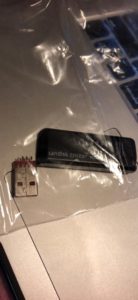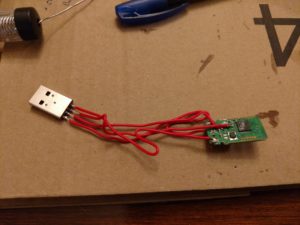Recently, a friend of mine broke a flash drive; she hit it while it was plugged in to her laptop, and broke the connector off of it. Being someone who dabbles in Electronics and soldering in general, I offered to attempt a repair.
I include this because it was the most difficult soldering job I’ve had to perform, mostly due to the size and spacing of the traces I had to solder to.
What she sent me was this:

When I opened it up, I discovered 3 of the 4 USB connector contacts were ripped off (only the 5V+ pad remained). The traces for the USB Data lines run right under the flash module, so some research was required to figure this out. Eventually I found images of the board without the flash module installed, and found that the traces ran through the board, and to the controller. The challenge, as I mentioned earlier, was the size and spacing of these traces; they were so small I couldn’t clearly photograph them with my phone (a 21MP camera), roughly a millimeter in width and spacing. Thankfully, they were fairly long, running roughly 2/3 of the board. So, I approached this from two directions, attaching one to one end of the traces (closer to the connector), and another to the other end (closer to the controller). After an hour or so of scraping silicon to expose the traces, and applying flux/solder to the contacts and some spare wire I had, I ended up with something like this (note, I wasn’t all that concerned with making these wires equal length, this is not likely to be reused):

All of the connections toned out where I expected them to, so it seemed physically successful.
After allowing the alcohol and glue to dry (I used a bit of Super Glue to hold the wires in place after soldering, the tiny contacts are a bit fragile), I connected it to my laptop, and was able to successfully pull the files from it.
Given that this was my first attempt at exposing traces and soldering to them, and I was working with traces I could barely see, I’m quite happy with the result. I may even try to use this in some other project in the future (it is a 128Gb drive, and I do have several Raspberry Pi boards).
Recent Comments